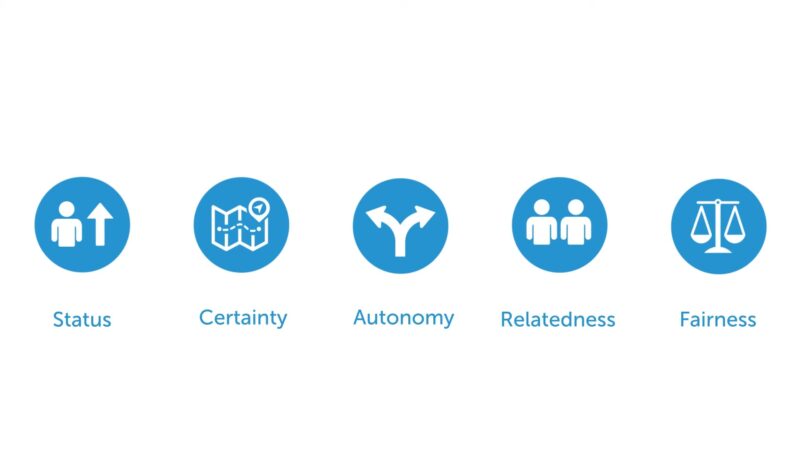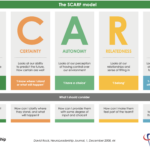Understanding the intricate motivations and triggers that drive human behavior is paramount, especially when we are talking about business. One model that has significantly illuminated these facets is the SCARF model.
Grounded in neuroscience, this model elucidates five primary dimensions that influence our social interactions, particularly within team settings. By learning the intricacies of the SCARF model, we will discover its foundational pillars and discern its transformative impact on modern teams.
The Background

Developed by Dr. David Rock, the SCARF model was introduced to help individuals and organizations better understand the social triggers that can lead to collaboration or conflict within team dynamics.
The acronym stands for five key domains: Status, Certainty, Autonomy, Relatedness, and Fairness.
This concept is not just theoretical; businesses and leaders use it as a practical tool. By identifying potential stressors or motivators in these five areas, one can preemptively address issues or harness positive triggers to enhance team performance.
The Five Domains
The strength of this model lies in its simplicity, breaking down complex human interactions into five understandable elements. While each can be a trigger for both positive and negative responses, understanding them aids in effective team management.
| Dimension | Description |
|---|---|
| Status | Refers to one’s relative importance to others. Teams flourish when members feel their contributions are valued |
| Certainty | Involves being able to predict the future. Clear communication and expectations can mitigate uncertainty |
| Autonomy | The sense of having control over one’s environment. Empowering team members boosts motivation |
| Relatedness | Covers the feeling of safety with others. Building trust is fundamental for effective teamwork |
| Fairness | This speaks to the perception of fair exchanges between people. Teams thrive when members feel treated equitably |
Applying to Modern Teams
In today’s fast-paced business world, understanding and leveraging the dynamics of team interactions is essential. Here, we’ll explore the application of the SCARF model in modern team settings.
The Model in Practice

With globalization and technological advancements, teams are more diverse and often dispersed geographically. This brings about unique challenges that can be better managed using the SCARF principles. For instance, remote teams may struggle with relatedness due to the lack of face-to-face interactions.
Leaders can counteract this by promoting virtual team-building exercises and ensuring regular check-ins. For autonomy, offering flexibility in work hours can be a significant motivator, especially for those juggling different time zones.
Benefits for Today’s Teams
Leveraging the SCARF model in the modern workplace has numerous advantages. By addressing each of the five domains proactively, leaders can foster a more harmonious and productive environment.
- Improved job satisfaction, as team members feel valued and understood.
- Enhanced productivity because of reduced conflicts and misunderstandings.
- Higher retention rates, as employees are more likely to stay in teams where they feel secure and valued.
The Timelessness of Human Behavior

At its core, the model is rooted in understanding human psychology. These five domains are based on fundamental human needs and desires, which have remained relatively constant across ages. While the specifics of team dynamics might shift with time and technology, the underlying triggers of human behavior remain consistent.
Recognizing this, leaders can adapt the principles of the SCARF model to any team environment, ensuring its enduring relevance.
Looking Ahead
As teams continue to evolve, so will the challenges they face. Yet, the SCARF model stands as a versatile tool, ready to address these changing dynamics.
Enhancing Team Dynamics with SCARF
As we have seen, the SCARF model provides a robust framework for understanding and improving team dynamics. But how can organizations take it a step further, ensuring that its principles become deeply embedded in their culture?
Incorporating the Model into Training Programs

Traditional team-building activities can sometimes fall flat, primarily when they aren’t rooted in human psychology. By integrating the SCARF principles into training modules, organizations can offer employees a deeper understanding of interpersonal dynamics.
Benefits:
- Improved collaboration as team members recognize and respect each other’s triggers.
- Enhanced leadership training, helping future leaders understand the nuances of managing diverse teams.
- Prevention of potential conflicts, as teams are equipped to recognize and navigate challenges proactively.
Building a SCARF-Centric Culture
Beyond just training, forward-thinking organizations can strive to build a culture centered around the SCARF principles. This involves recognizing and rewarding behaviors that align with these principles and incorporating them into performance assessments.
Action Steps:
- Regular feedback sessions that emphasize the importance of Status and Fairness.
- Encouraging autonomy by allowing employees to take the lead on projects or decisions.
- Hosting regular team-building activities that promote relatedness and build trust among team members.
Embracing Challenges
Even with the best of tools, challenges will arise in teams. The difference lies in how they’re approached. Using the SCARF model as a lens can turn these challenges into opportunities for growth.
Addressing Conflicts
Disagreements and conflicts are part and parcel of team dynamics. Rather than shying away, using the SCARF model can help in dissecting the root causes of such issues.
| Steps for Addressing Team Tensions Using SCARF |
|---|
| 1. Identifying which of the SCARF domains is causing tension |
| 2. Opening channels of communication to address concerns directly |
| 3. Implementing strategies or changes to alleviate the specific stressors |
Reinforcing Positive Behaviors

One of the most potent ways to solidify the principles of the SCARF model within a team is to recognize and reward positive behaviors that align with its domains.
Tactics:
- Celebrating team members who exemplify behaviors promoting status and relatedness.
- Providing additional responsibilities or projects to those who value autonomy, demonstrating trust in their abilities.
- Ensuring transparency in decisions to bolster feelings of fairness and certainty.
In Retrospect
As teams evolve and the business landscape changes, the SCARF model remains a consistent guide. It’s not just a one-off tool but an ongoing journey of understanding and adapting.
Continuous Learning and Adaptation
Embracing the SCARF model isn’t a destination but a journey. It requires regular introspection, feedback, and a willingness to adapt based on new insights and challenges.
The Cycle:
- Reviewing team dynamics regularly to identify areas of improvement.
- Seeking feedback from team members on their SCARF-related experiences.
- Iterating strategies and approaches based on this feedback.
The Enduring Promise
While many models and frameworks come and go in the business world, the SCARF model’s grounding in human psychology ensures its enduring relevance.
By committing to its principles and proactively seeking ways to embed them in team dynamics, organizations can pave the way for harmonious collaborations, increased productivity, and a more positive work environment for all.
Broader Business Landscape
As we understand the intricacies of the SCARF model within teams, it’s essential to step back and see its implications in the broader business landscape. Let’s explore how this model can shape organizational structures, strategies, and successes.
Organizational Design
Businesses are more than just structures and processes; they are comprised of people. Integrating the principles of the SCARF model into organizational design can lead to a more harmonious and effective workplace.
Implementation Insights:
- Creating hierarchies and roles that acknowledge and respect the ‘Status’ of employees.
- Designing workflows that provide ‘Certainty’ in processes, ensuring clarity and predictability.
- Encouraging a culture where employees have ‘Autonomy’ in decision-making, fostering a sense of ownership.
Strategic Decision-Making through the SCARF Lens
Strategic decisions can make or break an organization. Using the SCARF model as a guiding light can ensure these decisions are not only effective but also align with the needs and aspirations of the employees.
- Ensuring transparent communication to provide ‘Certainty’ about organizational direction.
- Creating strategies that prioritize ‘Fairness,’ ensuring equitable distribution of resources and rewards.
- Incorporating feedback mechanisms to promote ‘Relatedness’ and trust among all stakeholders.
The Age of Digital Transformation
The digital era has brought forth unprecedented changes in the way businesses operate. Here, we’ll see how the SCARF model remains relevant even as organizations undergo digital transformation.
The Digital Workplace
Adapting to Change: As businesses increasingly shift to digital platforms, the nature of work changes. Remote work, virtual teams, and digital tools become commonplace. In this environment, the principles of the SCARF model can provide stability and direction.
- Leveraging tools that promote ‘Relatedness’ in virtual teams, such as video conferencing and collaborative platforms.
- Providing training and resources to ensure ‘Certainty’ as employees adapt to new tools and technologies.
- Encouraging autonomy by empowering employees to make decisions in their digital roles, fostering a sense of trust and responsibility.
Navigating Digital Challenges with SCARF
While the challenges of the digital era might be new, the fundamental principles of human behavior remain unchanged. Using the SCARF model can aid organizations in navigating these new waters with confidence.
Solutions for the Digital Age:
- Addressing the ‘Status’ concerns of employees as roles evolve in the digital landscape.
- Ensuring ‘Fairness’ in the distribution of digital resources and tools.
- Prioritizing ‘Certainty’ by providing clear roadmaps and expectations in an ever-evolving digital environment.
FAQs
Why was the SCARF model created?
The SCARF model was formulated to offer insights into the primary human social triggers that influence our behavior in collaborative environments, aiding in improving team interactions and dynamics.
Can the principles of the SCARF model conflict with each other?
In certain situations, one domain might take precedence over another, creating potential conflicts. For instance, an action enhancing ‘Autonomy’ might reduce ‘Certainty’ for some team members. Balancing these domains is essential for harmonious team dynamics.
Where can one learn more about the intricacies of the SCARF model?
Multiple scholarly articles, books, and training sessions delve into the SCARF model’s details. Those interested can search for specialized courses or literature on the subject for a deeper understanding.
How do organizations measure the effectiveness of implementing the SCARF model?
Organizations can measure the model’s effectiveness through feedback surveys, observing changes in team cohesion, monitoring conflict resolution rates, and evaluating overall team performance improvements.
How does the SCARF model integrate with other team development frameworks?
The SCARF model complements many team development frameworks by providing a neuroscience-based perspective on social triggers. Its principles can be integrated with other methodologies to offer a more holistic approach to team dynamics.
The Bottom Line
The SCARF model, with its keen focus on the five essential domains of human interaction—Status, Certainty, Autonomy, Relatedness, and Fairness—provides a roadmap to navigate the complexities of team dynamics.
As businesses and teams continue to evolve in an ever-changing environment, having a tool grounded in the universality of human needs becomes indispensable. The model reminds us that beyond strategies, technologies, and processes, the success of teams fundamentally lies in understanding and valuing the human element.
Embracing the SCARF model is not just about optimizing team performance; it’s about forging deeper connections, fostering collaboration, and building workplaces where every individual feels valued and understood.
You can check out numerous similar topics on our website.




